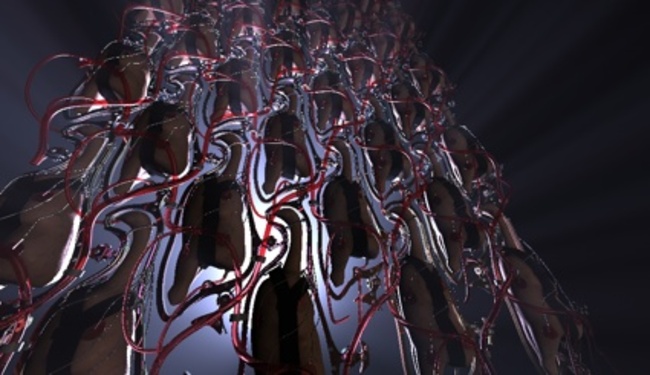 Image courtesy of André Ford and www.we-make-money-not-art.com
Image courtesy of André Ford and www.we-make-money-not-art.com
We read a thought-provoking article the other day about what might be the next era of industrial farming. A student at The Royal College of Art in the UK put up an installation detailing the potential “progress” that could be made in the ways of “efficiency” and “humane treatment”. The project was the result of a search for how dense and vertical architecture can bring food production back to cities.
The article can be read here: Farming the Unconscious, but at a high level it describes a reality where consumers and producers come to terms with the fact that animals should be treated as crops instead of as animals and thus the production systems should completely disregard animal welfare (which they pretty much already do anyway). After all, the British artist (André Ford) argues, “Animals are things we keep in our homes and watch on David Attenborough programs. 'Animals' bred for consumption are crops and agricultural products like any other. We do not, and cannot, provide adequate welfare for these agricultural products and therefore welfare should be removed entirely.” Since the system is already flawed he proposes taking it even further. Why torture these poor animals? Why not just anesthetize them and use technology to capitalize on their meat production capabilities?
As his example he uses meat chicken (broiler) production, "now the most intensified and automated type of livestock production". His design is rather ingenious, actually. Rather than cramming as many birds into a horizontal area, which uses up entirely too much space, we should construct a more vertical form of production system. In order to do this the chicken would first be desensitized (by separating the neocortex and the brain stem with a small incision) and then hooked up to some tubes where it would be tube-fed until it reached the desired weight. Then it would be harvested for meat, as usual. The waste would be reused as a form of compost (in the artist’s installation it was used to grow orchids). I imagine they could use automatic pickers to remove the chickens from their "home", just like they use at amazon.com warehouses. Human labor is far too expensive, after all.
His argument is hard to ignore. Food production has fallen to such a low point that the animal’s welfare is already completely disregarded, so the least we could do is remove their capacity to feel and rid them of their miserable existence, right? We still get food in the end, and I highly doubt it would be much lower quality (if that’s even possible). In some ways I really don’t see why the industrial farmers would disagree with him. As we’ve seen over the past 60 or so years, anything is acceptable in the name of efficiency and cheap food.
Of course, we disagree entirely with both production methods, but his argument and ideas are interesting to think about. Imagine a farmer in the 1890's looking at our current system. Wouldn't he have the same vomitous symptoms that you had while thinking about Ford's suggestion?
Here's my question to you. If you were a chicken, which “lifestyle” would you prefer? A.) The Current Industrial Method: crammed on a concrete floor with 20% chance of mortality/80% chance of a miserable life, or B.) The Ford Method: hooked up to a tube without any functional nerve-endings?
Difficulty choosing? Option C is roaming free on our farm this summer.


